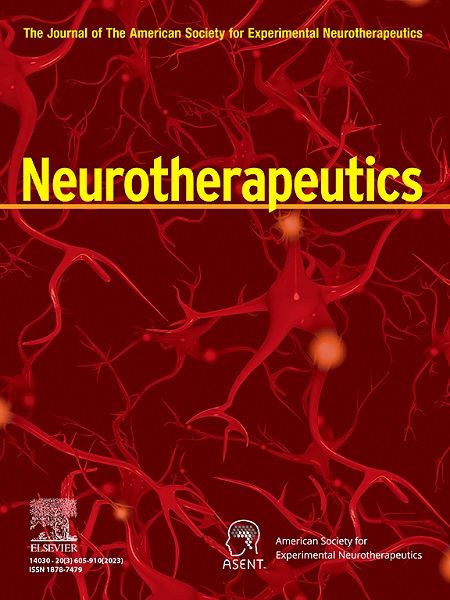肠道微生物群介导糖尿病相关认知衰退的半聚脲衰减。
IF 6.9
2区 医学
Q1 CLINICAL NEUROLOGY
引用次数: 0
摘要
糖尿病相关认知衰退(daca)是糖尿病(DM)的一种严重并发症,以认知功能障碍为特征。研究表明,semaglutide是一种新型的胰高血糖素样肽-1受体激动剂,具有神经营养和神经保护作用。然而,对西马鲁肽治疗ddad患者的具体作用和潜在机制的全面了解仍然缺乏。在这项研究中,我们评估了semaglutide缓解糖尿病小鼠ddad的潜力。8周龄的小鼠在高脂肪饮食中喂食链脲霉素诱导的糖尿病,皮下注射semaglutide (30 nmol/kg qd),持续12周。西马鲁肽可显著减轻认知障碍,抑制海马神经元丢失,改善海马突触超微结构,有效减轻神经炎症。此外,semaglutide处理增加了g_Alistipes、g_norank_f_Eubacterium_coprostanoligenes、g_Bacteroides和g_Parabacteroides的相对丰度,而降低了g_faecalibaculum、g_coldertribacter、g_GCA-900066575、g_丹参clostridium和g_norank_f_Lachnospiraceae的相对丰度。Semaglutide还诱导了粪便和血清代谢物的改变,以及脑组织的转录组变化,并在神经活性配体-受体相互作用中显著富集。此外,通过相关性分析和综合建模评估,在西马鲁肽影响基因、代谢物和微生物群之间观察到强相关性。总之,这些发现表明,西马鲁肽对daca的保护作用与微生物-肠-脑轴之间存在相关性。本文章由计算机程序翻译,如有差异,请以英文原文为准。

Gut microbiota mediates semaglutide attenuation of diabetes-associated cognitive decline
Diabetes-associated cognitive decline (DACD), characterized by cognitive impairment, is a serious complication of diabetes mellitus (DM). Research has shown that semaglutide, a novel glucagon-like peptide-1 receptor agonist, has neurotrophic and neuroprotective properties. However, a comprehensive understanding of the specific effects and underlying mechanisms of semaglutide treatment in patients with DACD remains lacking. In this study, we evaluated the potential of semaglutide to alleviate DACD in mice with DM. Eight-week-old mice fed a high-fat diet with streptozotocin-induced DM were subcutaneously injected with semaglutide (30 nmol/kg qd) for 12 weeks. Semaglutide administration significantly alleviated cognitive impairment, inhibited hippocampal neuron loss, improved the hippocampal synaptic ultrastructure, and effectively mitigated neuroinflammation. Furthermore, semaglutide treatment increased the relative abundances of g_Alistipes, g_norank_f_Eubacterium_coprostanoligenes, g_Bacteroides, and g_Parabacteroides, while decreasing the relative abundances of g_ faecalibaculum, g_Colodertribacter, g_GCA-900066575, g_Erysipelatoclostridium, and g_norank_f_Lachnospiraceae. Semaglutide also induced alterations in fecal and serum metabolites, as well as transcriptomic changes in brain tissue, with significant common enrichment in neuroactive ligand-receptor interactions. Furthermore, strong correlations were observed among semaglutide-affected genes, metabolites, and microbiota, as assessed by correlation analysis and integrative modeling. In conclusion, these findings suggest a correlation between the protective effects of semaglutide against DACD and the microbiota-gut-brain axis.
求助全文
通过发布文献求助,成功后即可免费获取论文全文。
去求助
来源期刊

Neurotherapeutics
医学-神经科学
CiteScore
11.00
自引率
3.50%
发文量
154
审稿时长
6-12 weeks
期刊介绍:
Neurotherapeutics® is the journal of the American Society for Experimental Neurotherapeutics (ASENT). Each issue provides critical reviews of an important topic relating to the treatment of neurological disorders written by international authorities.
The Journal also publishes original research articles in translational neuroscience including descriptions of cutting edge therapies that cross disciplinary lines and represent important contributions to neurotherapeutics for medical practitioners and other researchers in the field.
Neurotherapeutics ® delivers a multidisciplinary perspective on the frontiers of translational neuroscience, provides perspectives on current research and practice, and covers social and ethical as well as scientific issues.
 求助内容:
求助内容: 应助结果提醒方式:
应助结果提醒方式:


